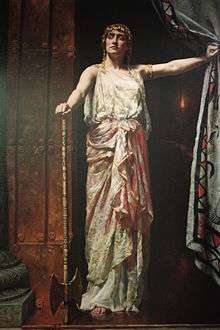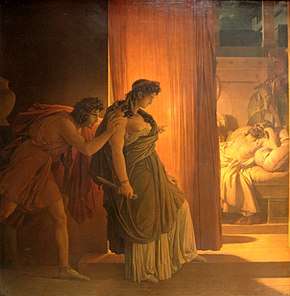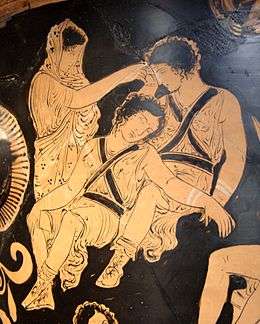Clytemnestra
Clytemnestra (/ˌklaɪtəmˈnɛstrə/;[1] Greek: Κλυταιμνήστρα, Klytaimnḗstra, [klytai̯mnɛ̌ːstra]), in Greek mythology, was the wife of Agamemnon, king of Mycenae, and the sister of Helen of Troy. In Aeschylus' Oresteia, she murders Agamemnon – said by Euripides to be her second husband – and the Trojan princess Cassandra, whom Agamemnon had taken as a war prize following the sack of Troy; however, in Homer's Odyssey, her role in Agamemnon's death is unclear and her character is significantly more subdued.
Name
Her Greek name Klytaimnḗstra is also sometimes Latinized as Clytaemnestra.[2] It is commonly glossed as "famed for her suitors". However, this form is a later misreading motivated by an erroneous etymological connection to the verb mnáomai (μνάoμαι, "woo, court"). The original name form is believed to have been Klytaimḗstra (Κλυταιμήστρα) without the -n-. The present form of the name does not appear before the middle Byzantine period.[3] Aeschylus, in certain wordplays on her name, appears to assume an etymological link with the verb mḗdomai (μήδoμαι, "scheme, contrive"). Thus given the derivation from κλῠτός (klutós "celebrated") and μήδομαι (mḗdomai "to plan, be cunning"), this would result in the quite descriptive "famous plotter".[4]
Background

Clytemnestra was the daughter of Tyndareus and Leda, the King and Queen of Sparta, making her a Spartan Princess. According to the myth, Zeus appeared to Leda in the form of a swan, seducing and impregnating her. Leda produced four offspring from two eggs: Castor and Clytemnestra from one egg, and Helen and Polydeuces (Pollux) from the other. Therefore, Castor and Clytemnestra were fathered by Tyndareus, whereas Helen and Polydeuces were fathered by Zeus. Her other sisters were Philonoe, Phoebe and Timandra.
Agamemnon and his brother Menelaus were in exile at the home of Tyndareus; in due time Agamemnon married Clytemnestra and Menelaus married Helen. In a late variation, Euripides's Iphigenia at Aulis, Clytemnestra's first husband was Tantalus, King of Pisa; Agamemnon killed him and Clytemnestra's infant son, then made Clytemnestra his wife. In another version, her first husband was King of Lydia. The kings of Lydia, according to Plutarch's The Greek Questions, 45,[5] having succeeded Omphale who had received from Herakles the axe of Hippolyte (the queen of the Amazons), carried this axe (called labrys by Lydians) as one of their sacred insignia of office. In the tradition following the Sicilian lyric poet Stesichorus's Oresteia[6] Clytemnestra used such a double-edged axe to assist her lover Aegisthus in the killing of Agamemnon (and later, to attempt to kill her son Orestes, as he arrived to avenge his father's death), as depicted on the mixing bowl (calyx krater) with the killing of Agamemnon (Early Classical Period – about 460 B.C.) by the Dokimasia Painter.[7]
Mythology
After Helen was taken from Sparta to Troy, her husband, Menelaus, asked his brother Agamemnon for help. Greek forces gathered at Aulis. However, consistently weak winds prevented the fleet from sailing on the ocean. Through a subplot involving the gods and omens, the priest Calchas said the winds would be favorable if Agamemnon sacrificed his daughter Iphigenia to the goddess Artemis. Agamemnon persuaded Clytemnestra to send Iphigenia to him, telling her he was going to marry her to Achilles. When Iphigenia arrived at Aulis, she was sacrificed, the winds turned, and the troops set sail for Troy.
The Trojan War lasted ten years. During this period of Agamemnon's long absence, Clytemnestra began a love affair with Aegisthus, her husband's cousin. Whether Clytemnestra was seduced into the affair or entered into it independently differs according to the respective author of the myth.
Nevertheless, Clytemnestra and Aegisthus began plotting Agamemnon's demise. Clytemnestra was enraged by Iphigenia's murder (and presumably the earlier murder of her first husband by Agamemnon, and her subsequent rape and forced marriage). Aegisthus saw his father Thyestes betrayed by Agamemnon's father Atreus (Aegisthus was conceived specifically to take revenge on that branch of the family).

In old versions of the story, on returning from Troy, Agamemnon is murdered by Aegisthus, the lover of his wife, Clytemnestra. In some later versions Clytemnestra helps him or does the killing herself in his own home. The best-known version is that of Aeschylus: Agamemnon, having arrived at his palace with his concubine, the Trojan princess Cassandra, in tow and being greeted by his wife, entered the palace for a banquet while Cassandra remained in the chariot. Clytemnestra waited until he was in the bath, and then entangled him in a cloth net and stabbed him. Trapped in the web, Agamemnon could neither escape nor resist his murderer.
Meanwhile, Cassandra saw a vision of herself and Agamemnon being murdered. Her attempts to elicit help failed (she had been cursed by Apollo that no one would believe her prophecies). She realized she was fated to die, and resolutely walked into the palace to receive her death.
After the murders, Aegisthus replaced Agamemnon as king and ruled for seven years with Clytemnestra as his queen. In some traditions they have three children: a son Aletes, and daughters Erigone and Helen. Clytemnestra was eventually killed by Orestes, her son by Agamemnon. The infant Helen was also killed. Aletes and Erigone grow up at Mycenae, but when Aletes comes of age, Orestes returns from Sparta, kills his half-brother, and takes the throne. Orestes and Erigone are said to have had a son, Penthilus.
_-_Google_Art_Project.jpg)
Appearance in later works
- She is one of the main characters in Aeschylus's Oresteia, and is central to the plot of all three parts. She murders Agamemnon in the first play, and is murdered herself in the second. Her death then leads to the trial of Orestes by a jury composed of Athena and 12 Athenians in the final play.
- Alexandre Soumet's tragedy Clytemnestre was successfully produced in 1822.
- The fictional protagonist Becky Sharp plays Clytemnestra in a charade described in chapter 51 of William M. Thackeray's novel Vanity Fair.
- In Ferdinando Baldi's The Forgotten Pistolero, a Spaghetti Western adaptation of the Oresteia, Clytemnestra is named Anna Carrasco and is portrayed by Luciana Paluzzi.
- The American modern dancer and choreographer Martha Graham created a two-hour ballet, Clytemnestra (1958), about the queen.
- Most recently, playwright and actor Corey Allen wrote a contemporary adaptation of Aeschylus' earlier work entitled Clytemnestra.
- The Aeschylus work was also adapted by South African composer Cromwell Everson into the first Afrikaans opera, Klutaimnestra, in 1967. In four acts, the opera premiered on November 7, 1967, in Biesenbach Hall, Worcester, Western Cape, South Africa.
- Rhian Samuel composed a 1994 work for voice and ensemble adapting Aeschylus' work from Clytemnestra's viewpoint.
- John Eaton composed an opera in one act entitled The Cry of Clytemnestra recounting the events leading up to and including Clytemnestra's murder of Agamemnon.
- She is a character in Jean-Paul Sartre's play The Flies.
- She is mentioned in comparison with a character from Agatha Christie's Nemesis (1971) by the name of Clotilde Bradbury-Scott. She often muses that she can see her planning and murdering her husband in a tub, but not a young girl.
- In the 1977 film adaptation Iphigenia, Clytemnestra is portrayed by the Greek actress Irene Papas.
- In the 2003 miniseries Helen of Troy, Clytemnestra is played by Katie Blake. As in the myth, she murders Agamemnon in revenge for sacrificing their daughter Iphigenia.
- She is the narrator of the first and last sections of Colm Tóibín's 2017 novel House of Names, a retelling of the story of Agamemnon, Clytemnestra, Iphigenia, Orestes, and Electra.
- Clytemnestra is the name of a race horse in Tristan Tzara's Dada play Le cœur à gaz (The Gas Heart) from 1921.
- Charlie Worthing, protagonist of Jasper Fforde's Early Riser finds a large painting of Clytemnestra in a room he rents. She is depicted having murdered Agamemnon after he entered winter hibernation.[8]
References
Citations
- "Definition of CLYTEMNESTRA". www.merriam-webster.com. Retrieved 2017-08-09.
- , , Vol. VI (ninth ed.), New York: Charles Scribner's Sons, 1878, p. 44.
- Oresteia, Loeb edition by Alan Sommerstein, introduction, p. x, 2008.
- Compare entry "Κλυταιμνήστρα", in Wiktionary.
- "The Roman and Greek Questions: The Greek Questions: 40-49". www.sacred-texts.com. Retrieved 23 March 2018.
- Davies, M.. (1987). "Aeschylus' Clytemnestra: Sword or Axe?". The Classical Quarterly, 37(1), 65–75.
- "Mixing bowl (calyx krater) with the killing of Agamemnon". mfa.org. 13 September 2016. Retrieved 23 March 2018.
- Fford, Jasper (Feb 12, 2019). Early Riser. Penguin. pp. 134–136. ISBN 0670025038.
Sources
- Servius. In Aeneida, xi.267.
External links

